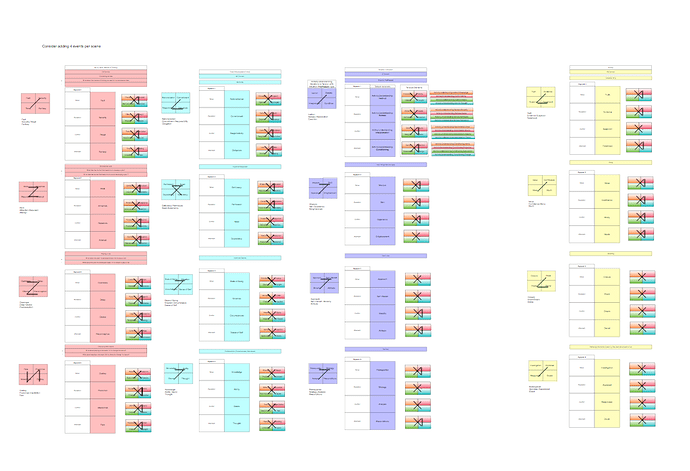I love Bob Raskopfs Table of Scene’s sheet, but wanted to transfer the idea to a graphical tool that lets me copy and duplicate elements and play with the format. I’m also fiddling with the format. My big PSR sheet looks like this:
Four throughlines in red, blue, purple and yellow. the red, yellow, purple and yellow squares are the PSR suggested variations, and beneath them Bob’s suggested elements.
Here’s a closeup of the most developed part of my tool. This is an extrapolation of Table of Scenes and the line fro the PSR "
In act one, “the current situation and circumstances” (The Present) is explored in terms of Instinct, Senses, Interpretation, and Conditioning."
(Ignore all the hairpins, they’re just placeholders)
The first thing you’ll notice is I always include the hierarchy in the name of a type, variation or element, using dot-notation, a trick I learned from programming. So Change element becomes Activity.Understanding.Conditioning.Change, so I can see the colors flowing out. Of course, if you follow the theory, there is also:
Activity.Understanding.Conditioning.Change.Change/Situation
Activity.Understanding.Conditioning.Change.Change/Activity
Activity.Understanding.Conditioning.Change.Change/Psychology
Activity.Understanding.Conditioning.Change.Change/State of Mind
…where the elements wrap around to the classes–that is, if I’m reading my theory correctly.
The other thing I’m doing is specifying the tensions in play, so I can keep them in mind.
It may be a bit much, I dunno, tell me what you think. Seems to me that surfacing the relationships constantly drills it into the writer’s head that they ARE relationships, and reminds you what a class, type, variation and element are and in what order they happen. Flattening out the heirarchy so you can easily see the whole in a single line, without having to drill down. Takes a little of the feeling of mystery out of it for me.
I also wrote out the bump-slide-bump scene breakout Armando recommends. I probably want to include the term there too.
And of course I show the SRCA structure, as Bob recommends.
Like I said, feedback would be great. Building this tool for myself as I commence on a big project and don’t want to have to keep looking stuff up. I’m going to incorporate definitions too, and I have a couple of ideas for how to do that too.



 Actually, I think your sheet is cool but I would leave lots of space to scribble the actual story stuff on it in pen.
Actually, I think your sheet is cool but I would leave lots of space to scribble the actual story stuff on it in pen.
